
Root all you want for your Chastains, your Rivas, your Hathaways, and your Day-Lewises; for me, the Oscar nominee to pull for this weekend is venerated cinematographer Roger Deakins, nominated ten times with nary a win to his name. He’s back in the race this year with the gorgeous, lush Skyfall, but Deakins is perhaps best known for his work with Joel and Ethan Coen, for whom he’s shot every film from Barton Fink to True Grit. I rang up the 63-year-old Brit this weekend to discuss some of the most iconic images he’s produced over his long career, though the first still I asked him to explain wasn’t from a Coen brothers film at all:
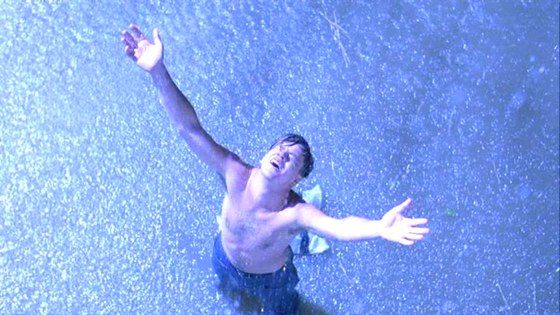
The Shawshank Redemption
That famous shot of Andy (Tim Robbins) escaping from the prison, arms outstretched as the rain pours down on him? You know, the moment so powerful that it was repurposed on the poster? Yeah, that wasn’t originally part of the plan. “It was a difficult schedule on that film, and we had quite a lot of night work scheduled for when Tim’s character escapes from the jail: He was going to run across the length of the field and catch a train that was going by the prison,” revealed Deakins, who earned his first Oscar nomination for shooting the film. “There was a lot of stuff planned, and schedule-wise, we just couldn’t do that. So this shot, with Andy standing there in the rain, had to be this iconic shot that signified the end of the sequence … because we couldn’t afford to shoot the rest of it, basically!”
The film came out in 1994, the same year another Tim Robbins–toplined, Deakins-shot movie with a funny name debuted. “One of my neighbors came up to me the other day and said, ‘You know, I really like Shawshank, but one of my favorite films is The Hudsucker Proxy!’” laughed Deakins, who noted another similarity between the Coen brothers comedy and Shawshank: “When The Hudsucker Proxy came out, hardly anybody saw it. It was quite a blow for the boys and me, because we’d put so much into that film, and I thought it was really good! But when Shawshank was released, too, it made nothing theatrically; then, when it had a video release, suddenly it was on the charts for a year. It’s all very odd.”
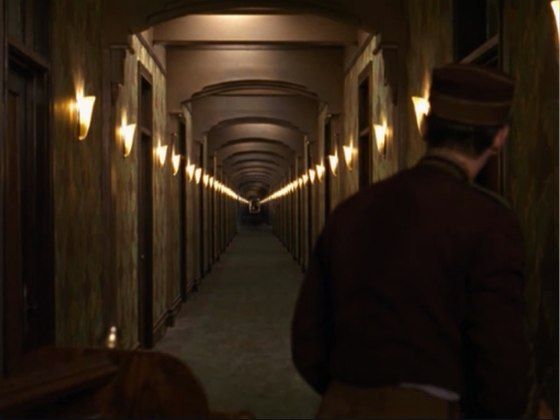
Barton Fink
Deakins first worked with the Coen brothers on their Palme d’Or winner Barton Fink, and he credits the 1991 film with rejuvenating his interest in cinematography. “I had kind of soured on the industry, I suppose,” he said. “I’d done a big movie that I wasn’t happy with and I was moving out of London when I got approached about Barton Fink, because my agent said the brothers were in London. We hit it off immediately, and suddenly I found myself on the way to America!” Was Deakins at all wary of shooting for two directors instead of one? “Obviously I hadn’t worked for two brothers before, and I didn’t know how it was going to work,” he said. “But we basically storyboarded the whole film together while I was staying with them in Santa Monica, and I realized very early on that they’re so in sync with the work they do. It feels like you’re dealing with one person, which makes things quite easy.”
As for that stretching-to-infinity image above, “The hallway shots were really tricky to do,” said Deakins, principally because the corridor had to go up in flames during the production. “We built the hallway in Long Beach somewhere, and we basically built two, because we were going to burn one! That one was rigged with gas, recessed in the walls, and all the wallpaper was perforated so the gas would come through it. It was quite interesting, and it worked really well, actually.”
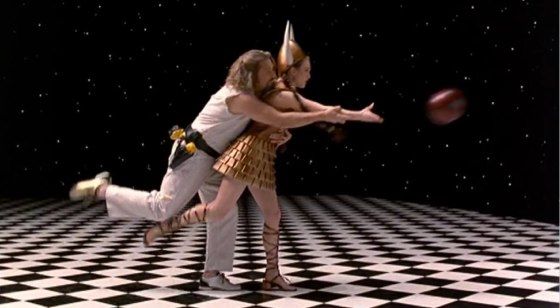
The Big Lebowski
“We were all laughing so much!” Deakins said of this trippy Big Lebowski dream sequence, where Jeff Bridges and Julianne Moore cavort among dancers wearing bowling-pin headdresses. “We were trying to re-create a Busby Berkeley feel. It was a high-key, very lit sequence; I wanted it kind of bright and white.” Again, it helped that the Coen brothers had such an exacting vision of how they wanted the sequence to look. “I’ve never worked with anybody else who storyboards like they do,” said Deakins. “We storyboarded some sequences on Skyfall, and we’re doing some storyboards on the film I’m working on at the moment, but those are kind of a reference and not something that you necessarily stick to. On a Coen brothers movie, it’s much more of a template for what you actually shoot, especially this sequence in Lebowski. You could look at the images on file, and there’s not much variation.”
O Brother, Where Art Thou?
When the singing sirens bewitch George Clooney, John Turturro, and Tim Blake Nelson during this O Brother sequence, how did Deakins pull off that wowser last shot, where each man and his siren float in and out of frame past each other? “The camera was on a track, but each of the characters and their women were on tracks as well, moving sort of independently,” Deakins said. “It was quite a complicated little shot to set up, as I remember, but it was a specific feeling that the boys were after, with everything slowly moving slightly out of sync.”
The 2000 film pioneered the extensive use of digital color correction in order to achieve its warm autumnal look. “Early on in prep, we talked about how they were doing some digital work on Pleasantville, so you knew that people were starting to use the technology,” said Deakins. “But I spent, wow, I don’t even know how long trying to achieve that look photochemically through different processes. It was just not possible, and also, we were locked into a schedule where we were shooting in Mississippi in the height of summer, so you knew that everything was going to be so green, which was exactly what the boys didn’t want!”
Deakins earned another Oscar nomination for the film, but at the time, other cinematographers sniped that because so much of the look was created in a computer, the nod wasn’t fully deserved. “That’s funny now, isn’t it, when you look at all the films using it, and half of them shot with digital cinematography?” Deakins laughed. “I thought that was a pretty stupid argument, really, because it’s the final product that matters. The look of the film, however it’s done, is still the cinematographer’s vision in my mind. People said the same when color film came in, didn’t they? The world evolves, and image-making evolves.”
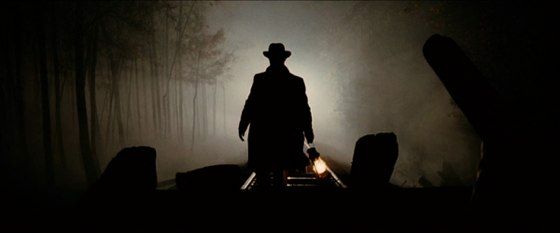
The Assassination of Jesse James by the Coward Robert Ford
The closest Deakins has come to an Oscar win was surely in 2008, when he was nominated twice for Jesse James and No Country for Old Men. And though he lost the top prize to There Will Be Blood cinematographer Robert Elswit, the beautifully composed work Deakins did on Jesse James may be the best of his career, with this gorgeous train-robbery sequence serving as a particular standout. “These sorts of sequences terrify me when I’m thinking about them, and I often don’t come to the final idea about the look of it until I’m actually there on the night,” said Deakins. “For this one, I thought to have it particularly dark, so I put this one lamp on the front of the train, so that it would just be this one lamp coming out of the darkness. But I’d also put up these cranes with little lights on them because I was a bit nervous about going so dark, so I cross-lit the forest very minimally, just so you could see the train tracks.” Ultimately, Deakins decided to trust his gut. “We were very lucky because it was a cold, still night, and the smoke just hung in the air above the train tracks. When I saw the way that the light on the train just blew through the smoke, I decided to turn all the other lights off and just go with that. Everyone, including my gaffer, just looked at me like, ’What?’ But it was worth taking the chance.”
Fargo
Again, Deakins experimented with how little light he could get away with during two scenes in Fargo — one set during the day, and another shot at night — where tiny car headlights provide the only pinprick of illumination in this snow-covered setting. “That was sort of a thematic thing that we came up with early on,” said Deakins. “I suppose that night sequence of the car chase in Fargo actually informed me on how to shoot Jesse James.”
As for that credits sequence, which opens the movie to the tune of Carter Burwell’s plaintive score, well … “The funny thing about shooting the opening sequence is that neither Joel, Ethan, or I were actually there!” admitted Deakins. “We were shooting on the sixteenth floor of this office building, but we knew this blizzard was coming in, and just schedule-wise, we were locked into the office scene. So I sent my assistant Robin out to shoot that sequence, but we had marked every shot with the cars, we had walked through and put stakes on the ground and knew where every camera went.” Continued Deakins, “A lot of the snow in Fargo had to be created, actually. When Bill Macy scrapes off his car in the parking lot, that was all created. We got very little snow during that shoot, and that’s why we weren’t available to shoot that opening sequence; we just sent Robin out to shoot it when we finally got enough snow.”
No Country for Old Men
“I think that was one of the most difficult sequences I’ve ever done, really,” said Deakins of this bravura No Country scene, which goes from night to dawn as Josh Brolin is pursued by criminals … and one very ardent pit bull. “I’m not 100 percent happy with it, but I’m not 100 percent happy with anything, really. It was really hard to do, given our budget and schedule.” In order to capture the dawn shots, Deakins shot some in the morning and some at magic hour, though he confessed that he can tell which came when: “We were filming in New Mexico, and the weather is so different in the mornings and the evenings. Nobody really notices it, but it’s obvious to me that the clouds build up during the day and you’ve got a lot of them in the evening shots, while the morning shots are crystal clear. There are quite a few of those mismatches.”
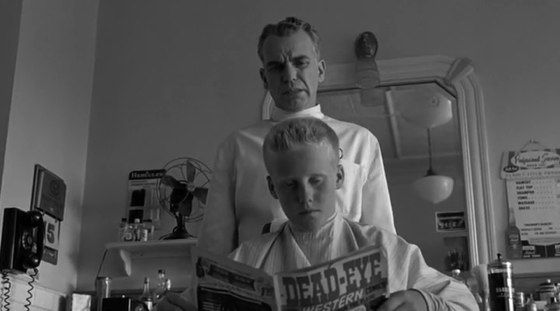
The Man Who Wasn’t There
For the Coen brothers’ foray into black-and-white filmmaking, Deakins had a tricky hurdle to overcome. “The film was actually shot in color, for various reasons,” he said. “They wanted a color release in Europe, which never really happened, but I would have shot on color anyway because the quality of image that I wanted was better. Black and white stocks haven’t changed in years and years, basically, whereas with color stock, there’s far less grain and there’s far more range.” Besides, that old-timey image fidelity wasn’t important to Deakins, he said: “I didn’t want a traditional-looking black-and-white movie, though it’s got a lot of homages to the thirties and forties. But I didn’t want that look; I wanted something that was much smoother and much more modern, I suppose.”
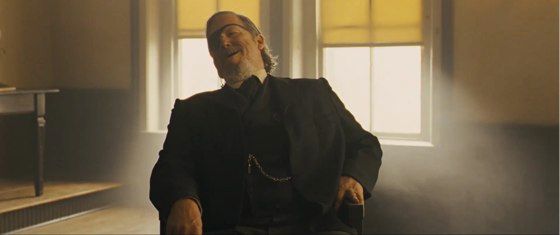
True Grit
The first time you see Jeff Bridges in the Coen brothers’ remake of True Grit, you barely get a glimpse: Only once Mattie Ross (Hailee Steinfeld) is able to push her way through the crowded courthouse do you actually see Bridges in full, bathed in backlight. “That was a very deliberate choice that the boys had made, that the introduction to the character come from Mattie’s point of view,” said Deakins. “True Grit was very well thought out, the boys knew exactly what they wanted from each sequence.” He paused, then laughed. “Well … the shafts of sunlight may not have been in the storyboards.” Was that an homage to fellow cinematographer Janusz Kaminski, who’s famous for flooding his Steven Spielberg films with light streaming in from the windows? “That’s funny! I’ll have to tell him that. No, not at all. I know Janusz very well, but I like playing with light. It was kind of a tricky setup; we had these big spotlights outside, one on each window. Janusz can do it brilliantly, and so can Bob Richardson! But I don’t do it that much, I suppose.”
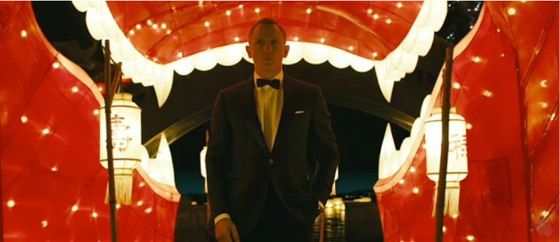
Skyfall
For this shot of James Bond arriving in Macau on the water, “The challenge was just to rig the amount of little lights,” said Deakins. “It was actually shot in the tank on the backlot at Pinewood, and we had something like 300 floating lights. The idea was that it supposed to be these candles, and obviously that wasn’t going to work, because we were shooting in early March and it was cold!” Deakins has been lauded for his beautiful digital cinematography in Skyfall, but he brushes those compliments off easily. “Whether or not it’s film or digital, much more of my career has been about choosing the location, getting an idea of the look of something, and choosing the practical kinds of lighting and the positions of the windows, anything that enables you to get the look you want,” he says. But is it easier to deal with digital photography, especially since so much of Skyfall is filmed with low lighting? “Easier? No, I don’t think so,” he laughed. “Maybe it makes you feel a little more secure that you can see what you’re recording on set, instead of waiting to see the dailies the next day. But still, it’s about choices.”

